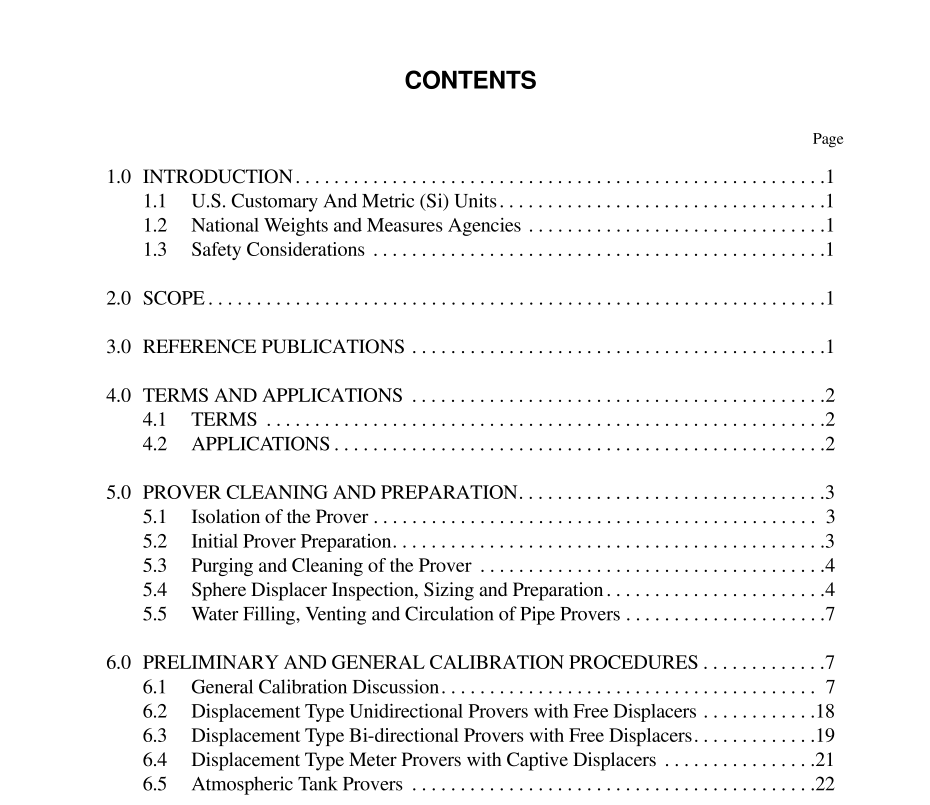API MPMS 4.9.2 pdf download

API MPMS 4.9.2 pdf download.Manual of Petroleum Measurement Standards Chapter 4—Proving Systems
5.1 ISOLATION OF THE PROVER
The prover and its auxiliary piping shall be isolated from all operating systems by either physical isolation with blinds, blind flanges, blanks, spectacles or double block and bleed valves to separate it from the upstream and downstream operating line pres- sures and products. A complete visual inspection should be made of the entire prover system to assure that the system is properly isolated.
5.2 INITIAL PROVER PREPARATION
New or repaired provers are generally hydrostatically tested prior to placing into service. When a hydrostatic test is required, it shall be conducted prior to the waterdraw calibration. This ensures that the calibrated volume will not be altered by permanent pipe expansion, subsequent tightening of flanges, etc. Piston provers shall be waterdrawn using the same piston design and seals, both material and style, that are utilized in the prover’s normal meter proving operation. Substitution of spheres for the piston dur- ing calibration shall not be allowed. Connections to pipe work or flexible hoses are required for water circulation through the prover. These are typically 2 in. threaded connections, which should be as close to the calibrated section as practical. (If vents and drains are being considered for water- draw connections, their location should ensure that all the water used in the calibration will be circulated through the entire prov- ing system. This is necessary to maintain constant temperature in the calibration water.) Adequate water flow is required to launch the displacer in a pipe prover. High point vent valves should be inspected. If damaged, defective or leaking they should be repaired or replaced prior to the cali- bration. Vent valves, in good working order, are necessary for all prover calibrations, to ensure that all air or vapor has been vented from the prover prior to the start of each calibration pass. Before a prover calibration, all relief valves should be removed, checked for leakage, repaired and re-calibrated as necessary. If in place during the prover calibration then the relief valves should be isolated. If not isolated they must be disconnected from the drain system and regular visual checks for any leakage shall be made.
5.3 PURGING AND CLEANING OF THE PROVER
Provers in batched crude oil service should be purged with the least viscous available crude unless there is on-site availability of other light hydrocarbon products that can be used. Regardless of service the prover and associated piping shall be cleaned by the best means available and flushed with water until free of all traces of hydrocarbon liquids and solids. Valves may need to be oper- ated to ensure that no hydrocarbon remains. The most widely used method is running the prover displacer back and forth during the water-flush to scrub the walls. Another method, used in crude oil service is to use a hot oil truck to circulate hot water through the prover while pushing the displacer back and forth. When available, steam cleaning is a method for removing wax, paraffin, etc. Pull-through foam pipeline pigs can also be used as an alternative or an additional method of cleaning the interior of pipe provers. Caution should be taken to prevent damage to the internal coating during the cleaning process. While a detergent can be effective in cleaning a prover, all traces of it must be removed prior to the calibration to prevent foaming. This can sometimes be very difficult to achieve. Therefore, the use of detergents is discouraged except in extreme cases. If it is decided that a detergent has to be used, only a non-suds type should be considered. Even then, it may take a great amount of water to fully remove all traces of the detergent. Nonetheless, all traces of the presence of any detergent must be totally removed before beginning the waterdraw calibration. LPG pipe provers are best cleaned by filling with water and moving the displacer back and forth to scrub the walls. It is recom- mended that the prover be drained, refilled and then allowed to stand overnight. The prover is then drained and flushed with clean water. Experience has demonstrated that this procedure eliminates LPG vapors from the piping that can become entrained in the water during the calibra









